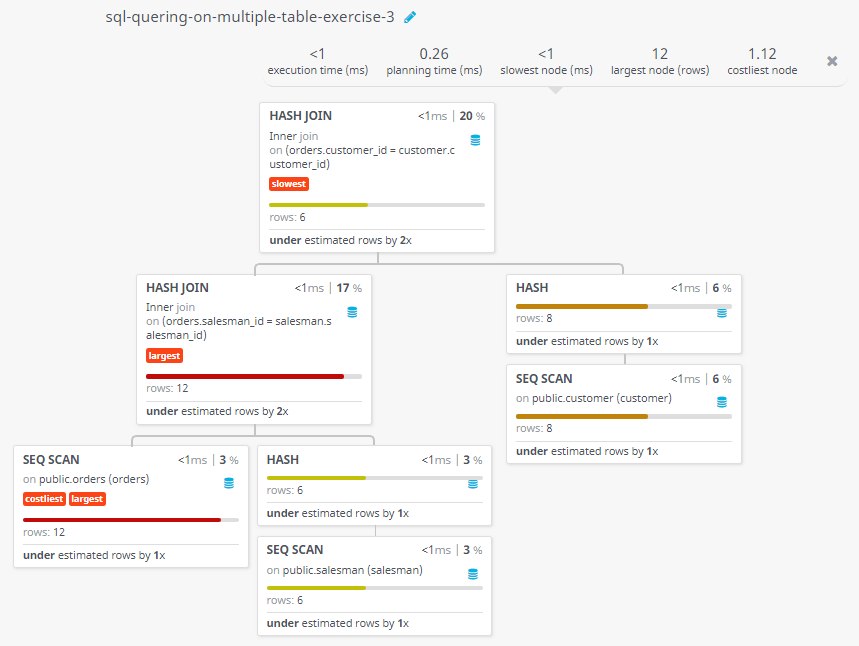SQL Exercises: Customer lives in a city other than the salesman's
Different City Orders
From the following tables, write a SQL query to find those salespeople who generated orders for their customers but are not located in the same city. Return ord_no, cust_name, customer_id (orders table), salesman_id (orders table).
Sample table: salesman
salesman_id | name | city | commission
-------------+------------+----------+------------
5001 | James Hoog | New York | 0.15
5002 | Nail Knite | Paris | 0.13
5005 | Pit Alex | London | 0.11
5006 | Mc Lyon | Paris | 0.14
5007 | Paul Adam | Rome | 0.13
5003 | Lauson Hen | San Jose | 0.12
Sample table: customer
customer_id | cust_name | city | grade | salesman_id
-------------+----------------+------------+-------+-------------
3002 | Nick Rimando | New York | 100 | 5001
3007 | Brad Davis | New York | 200 | 5001
3005 | Graham Zusi | California | 200 | 5002
3008 | Julian Green | London | 300 | 5002
3004 | Fabian Johnson | Paris | 300 | 5006
3009 | Geoff Cameron | Berlin | 100 | 5003
3003 | Jozy Altidor | Moscow | 200 | 5007
3001 | Brad Guzan | London | | 5005
Sample table: orders
ord_no purch_amt ord_date customer_id salesman_id ---------- ---------- ---------- ----------- ----------- 70001 150.5 2012-10-05 3005 5002 70009 270.65 2012-09-10 3001 5005 70002 65.26 2012-10-05 3002 5001 70004 110.5 2012-08-17 3009 5003 70007 948.5 2012-09-10 3005 5002 70005 2400.6 2012-07-27 3007 5001 70008 5760 2012-09-10 3002 5001 70010 1983.43 2012-10-10 3004 5006 70003 2480.4 2012-10-10 3009 5003 70012 250.45 2012-06-27 3008 5002 70011 75.29 2012-08-17 3003 5007 70013 3045.6 2012-04-25 3002 5001
Sample Solution:
-- This query selects specific columns ('ord_no', 'cust_name', 'orders.customer_id', 'orders.salesman_id') from the 'salesman', 'customer', and 'orders' tables.
-- It retrieves data where the 'city' column in the 'customer' table is not equal to the 'city' column in the 'salesman' table.
-- Additionally, it ensures that the 'customer_id' column in the 'orders' table matches the 'customer_id' column in the 'customer' table,
-- and the 'salesman_id' column in the 'orders' table matches the 'salesman_id' column in the 'salesman' table.
SELECT ord_no, cust_name, orders.customer_id, orders.salesman_id
-- Specifies the tables from which to retrieve the data (in this case, 'salesman', 'customer', and 'orders').
FROM salesman, customer, orders
-- Specifies the conditions for joining the tables and filtering the data.
WHERE customer.city <> salesman.city
AND orders.customer_id = customer.customer_id
AND orders.salesman_id = salesman.salesman_id;
Output of the query:
ord_no cust_name customer_id salesman_id 70004 Geoff Cameron 3009 5003 70003 Geoff Cameron 3009 5003 70011 Jozy Altidor 3003 5007 70001 Graham Zusi 3005 5002 70007 Graham Zusi 3005 5002 70012 Julian Green 3008 5002
Code Explanation:
The said query in SQL that joins the 'salesman', 'customer', and 'orders' tables. The result set includes the order number (ord_no), customer name (cust_name), customer ID (customer_id), and salesman ID (salesman_id). The WHERE clause specifies multiple conditions for the join.
There is a first condition that must be fulfilled in order for the city column in the customer table to not be the same as the city column in the salesman table.
The second and third conditions specify the join conditions between the orders table and the customer and salesman tables, respectively, which is that the customer_id and salesman_id columns of the orders table must be equal to the corresponding columns in the customer and salesman tables.
Relational Algebra Expression:
Relational Algebra Tree:
Explanation:
Visual presentation :
Go to:
PREV : Customer-Salesperson Association.
NEXT : Customer Orders Listing.
Practice Online
Query Visualization:
Duration:
Rows:
Cost:
Note: The pictorial represetation above is based on hypothetical table for the purpose of explanation only. Your answer may not match.
For more Practice: Solve these Related Problems:
- Write a SQL query to list order numbers and customer names for orders where the customer's city differs from the salesperson’s city and the order amount is above 100.
- Write a SQL query to display distinct salespeople who have processed orders for customers in a different city, along with the total count of such orders.
- Write a SQL query to retrieve order details for orders handled by salespeople not residing in the same city as their customers, filtering out orders before a specific date.
- Write a SQL query to show order numbers and customer IDs for orders executed by salespeople in a different city than the customer, grouped by salesperson.
- Write a SQL query to list distinct salespeople and order numbers where the salesperson’s city does not match the customer’s city and the customer's grade is above 150.
Have another way to solve this solution? Contribute your code (and comments) through Disqus.
What is the difficulty level of this exercise?
Test your Programming skills with w3resource's quiz.







